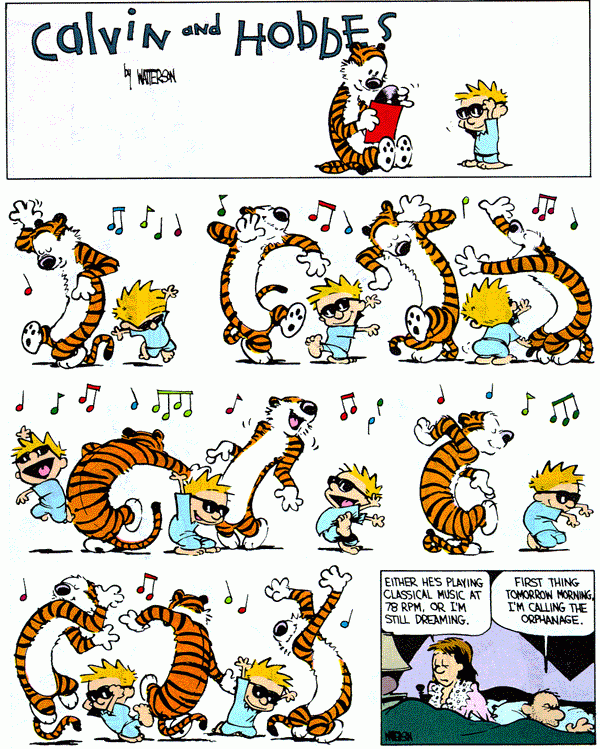BILL WATTERSON: A cartoonist's advice
Jay Liew stashed this in career, life hacks
Stashed in: General Wisdom, #lifehacks, #happiness, Advice, Calvin and Hobbes!, Awesome, Meaning of Life, Jobs, Comics!, Zen Pencils, HumanNature
This is awesome.
So is the write up on the Zen Pencils website:
http://zenpencils.com/comic/128-bill-watterson-a-cartoonists-advice/
Great post!. Thank you. It soothes the Soul.
Tina, I agree!
The quote used in the comic is taken from a graduation speech Watterson gave at his alma mater, Kenyon College, in 1990.
Brain Pickings has a nice article about it.
I also stashed the Brain Pickings article here:
Hi Adam. Thanks!
ha, I just realized that PandaWhale created a new stash called "career, life hacks" instead of what I intended, which is to stash it into both, "career" and "life hacks".
Zen Pencils brings up some very good points:
After getting fired as a political cartoonist at the Cincinnati Post, Watterson decided to instead focus on comic strips. Broke, he was forced to move back in with his parents and worked an advertising layout job he hated while he drew comics in his spare time. He stayed at this miserable job and submitted strips to comic syndicates for four years before Calvin and Hobbes was accepted. About this period Watterson wrote: “The only way to learn how to write and draw is by writing and drawing … to persist in the face of continual rejection requires a deep love of the work itself, and learning that lesson kept me from ever taking Calvin and Hobbes for granted when the strip took off years later.”(Also see the Advice for Beginners comic.)
• Watterson sacrificed millions (probably hundreds of millions) of dollars by never licensing and merchandising Calvin and Hobbes. He went through a long and traumatic fight with his syndicate over the licensing rights, and although he eventually prevailed, Watterson was so disillusioned with the industry he almost quit cartooning. “I worked too long to get this job, and worked too hard once I got it, to let other people run away with my creation once it became successful. If I could not control what my own work was about and stood for, then cartooning meant very little to me.”
• Luckily Watterson didn’t quit and took a sabbatical instead. Eager to reinvigorate his creative mojo on his return, Watteron proposed a radical new layout for his colour Sunday strips. For those not familiar with comic strip lingo, each week a newspaper comic will have six ‘daily’ strips (usually black and white, one tier, 3-4 panels) and one ‘Sunday’ strip which is larger and in colour. Previously, the Sunday strip was comprised of three tiers of panels and looked like this. The layout was restrictive and the top tier had to be completely disposable because a lot of newspapers would cut it and only run the bottom two tiers in order to save space so they could cram in as many comics (or puzzles, or ads) as they could.
Watterson was sick of the format restraints and wanted more space to experiment and push his storytelling ability so he (with his syndicate’s support) gave newspaper editors a ballsy proposition. They would have to publish his Sunday comics at a half-page size with no editing, or not publish it at all. By this time Calvin and Hobbes had been running for over five years and was extremely successful so Watterson had the clout needed to pull this move off. Despite fearing many cancellations, he was pleasantly surprised that most newspapers supported the change. Free of the shackles of tiers and panel restrictions, Watterson gave us visually exciting and beautiful strips that hadn’t been since the glory days of newspaper comics in the 1920s and 30s. He was free to create strips like this, and this and this. “The last few years of the strip, and especially the Sundays, are the work I am the most proud of. This was close as I could get to my vision of what a comic strip should be.”
• After working on the strip for 10 years, when Calvin and Hobbes was at the height of its popularity and was being published in over 2,000 newspapers, Watterson stopped. He had given his heart and soul to one project for 10 years, had said all he wanted to say and wanted to go out on top. “I did not want Calvin and Hobbes to coast into half-hearted repetition, as so many long-running strips do. I was ready to pursue different artistic challenges, work at a less frantic pace with fewer business conflicts, and … start restoring some balance to my life.” Since retiring the strip, Watterson has pursued his interest in painting and music.
It’s pretty incredible when you think about. Could you say ‘no’ to millions, I repeat, MILLIONS of dollars of merchandise money? I don’t know if I could. Would you stop creating your art if millions of people admired your work and kept wanting more? I don’t know if I would.
Hurray for Watterson and his determination not to bow to the phony values often found in the business community.
It's admirable in part because it is so rare.














11:45 AM Aug 28 2013